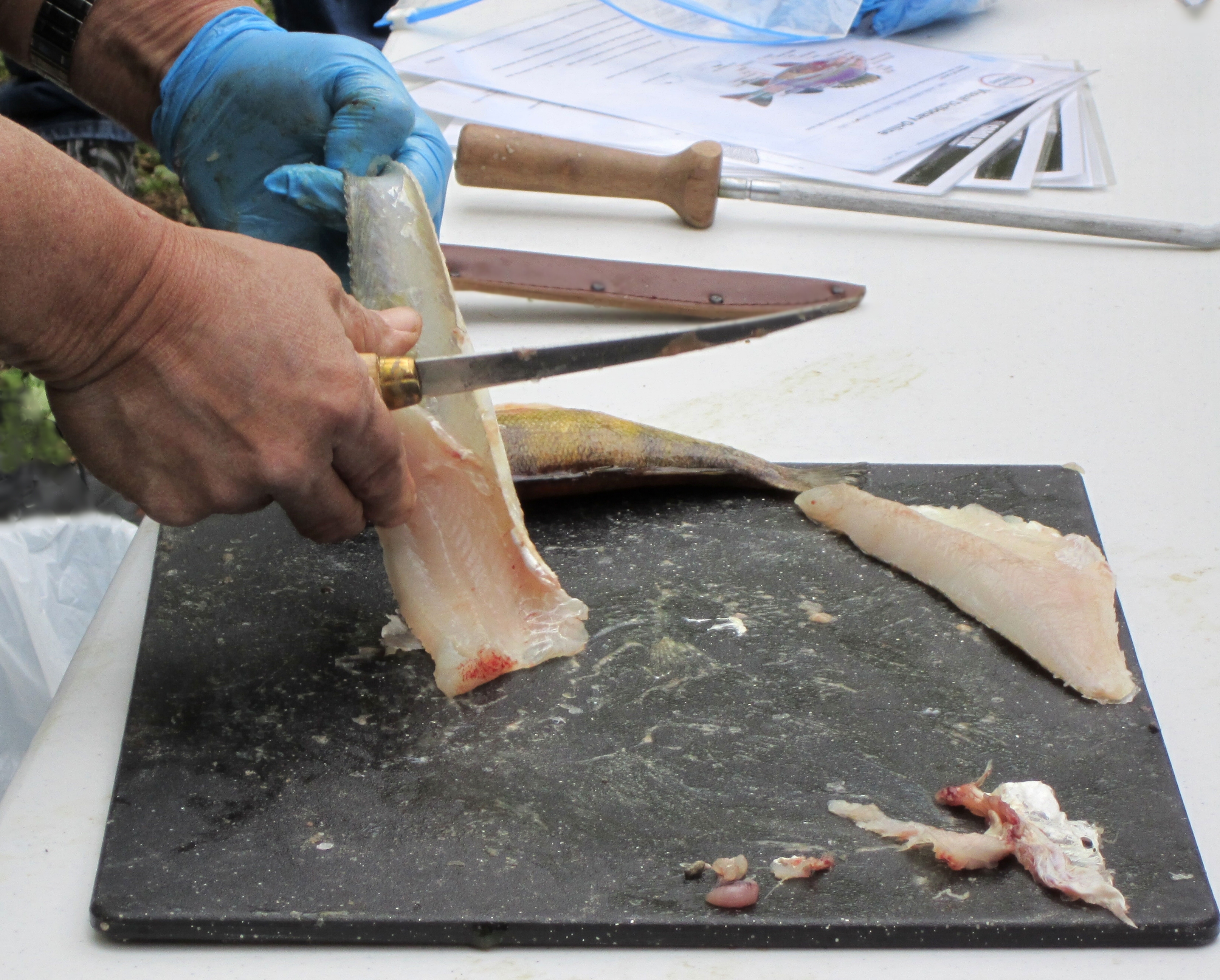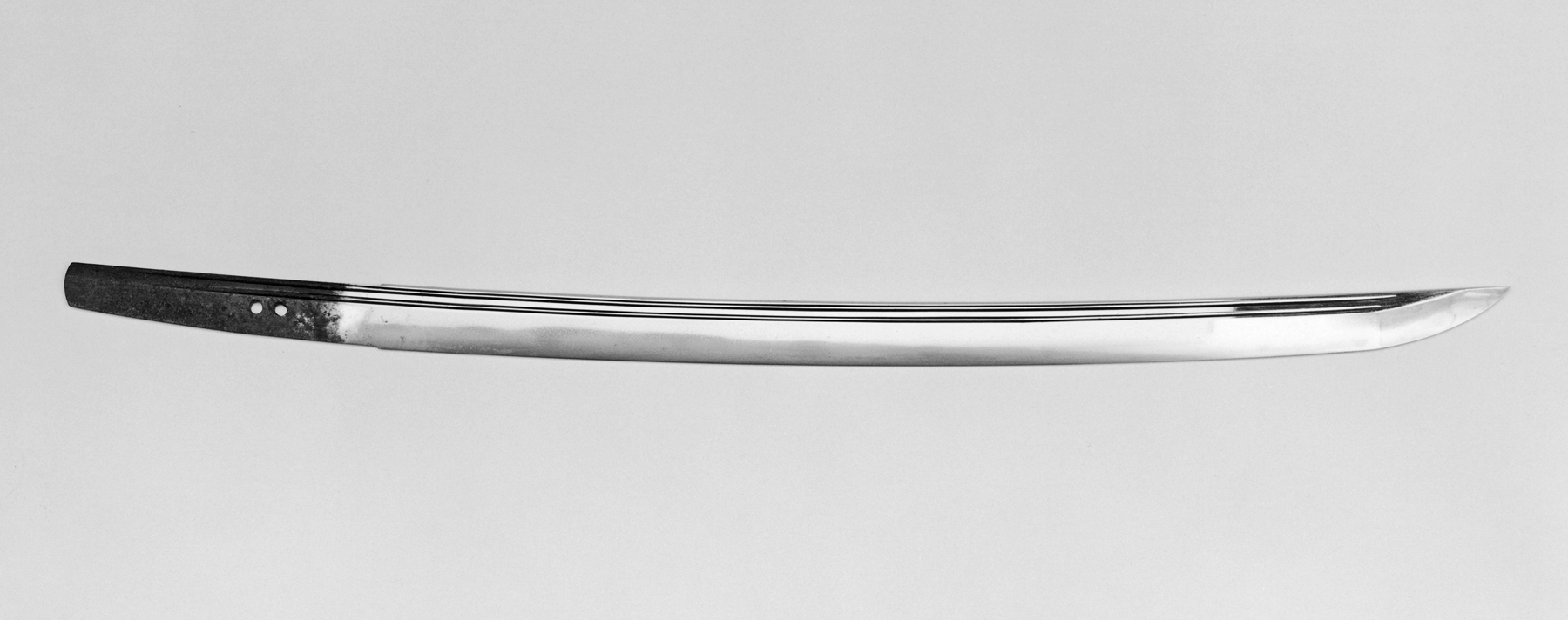|
Fillet Knife
A fillet knife (also called a filleting knife) is a kitchen knife used for filleting. It gives good control and aids in filleting. It is a very flexible member of the boning knife family that is used to filet and prepare fish. Fillet knife blades are typically long. This allows them to move easily along the backbone and under the skin of meat. Blade Most fillet knives utilize a trailing point blade which is made for slicing and skinning. The back edge of a trailing point blade curves upwards gently from the handle to the tip. The curve of the back edge maximizes the size of the knife belly, the curved part of the cutting edge. The large belly of the trailing point blade makes it ideal for quick precise cuts. Material Fillet knife blades are made of various types of materials. Stainless steel is often used. Since fillet knives are frequently wet, additional chromium in stainless steel blades makes the knives resist corrosion. Also, since fillet knives are used to prepare m ... [...More Info...] [...Related Items...] OR: [Wikipedia] [Google] [Baidu] |
Kitchen Knife
A kitchen knife is any knife that is intended to be used in food preparation. While much of this work can be accomplished with a few general-purpose knives – notably a large chef's knife, a tough cleaver, a small paring knife and some sort of serrated blade (such as a bread knife or serrated utility knife) – there are also many specialized knives that are designed for specific tasks. Kitchen knives can be made from several different materials. Construction Material * Carbon steel is an alloy of iron and carbon, often including other elements such as vanadium and manganese. Carbon steel commonly used in knives has around 1.0% carbon (ex. AISI 1095), is inexpensive, and holds its edge well. Carbon steel is normally easier to resharpen than many stainless steels, but is vulnerable to rust and stains. The blades should be cleaned, dried, and lubricated after each use. New carbon-steel knives may impart a metallic or "iron" flavour to acidic foods, though over time, the ste ... [...More Info...] [...Related Items...] OR: [Wikipedia] [Google] [Baidu] |
Fillet (cut)
A fillet or filet (, ; from the French word , ) is a boneless cut or slice of meat or fish. The fillet is often a prime ingredient in many cuisines, and many dishes call for a specific type of fillet as one of the ingredients. Meat Beef In the case of beef, the term most often refers to beef tenderloin in the United States, especially filet mignon. Chicken Chicken filets, sometimes called inner filets, are a specific cut of meat from the chicken or ostrich steaks. There are two filets in a chicken, and they are each a few inches long and about 1 inch or less wide. They lie under the main portion of the breast just above the ribcage around the center of the sternum. They are separated from the main breast by filament. Chicken filets are very popular in supermarkets in many countries. They can come attached to the main breast itself or separated from the breast in packages of generally four or more filets. File:Kycklingfilé.jpg, Raw chicken filets File:Schweinefilet-1. ... [...More Info...] [...Related Items...] OR: [Wikipedia] [Google] [Baidu] |
Fish
Fish are aquatic, craniate, gill-bearing animals that lack limbs with digits. Included in this definition are the living hagfish, lampreys, and cartilaginous and bony fish as well as various extinct related groups. Approximately 95% of living fish species are ray-finned fish, belonging to the class Actinopterygii, with around 99% of those being teleosts. The earliest organisms that can be classified as fish were soft-bodied chordates that first appeared during the Cambrian period. Although they lacked a true spine, they possessed notochords which allowed them to be more agile than their invertebrate counterparts. Fish would continue to evolve through the Paleozoic era, diversifying into a wide variety of forms. Many fish of the Paleozoic developed external armor that protected them from predators. The first fish with jaws appeared in the Silurian period, after which many (such as sharks) became formidable marine predators rather than just the prey of arthropods. Mos ... [...More Info...] [...Related Items...] OR: [Wikipedia] [Google] [Baidu] |
Blade
A blade is the portion of a tool, weapon, or machine with an edge that is designed to puncture, chop, slice or scrape surfaces or materials. Blades are typically made from materials that are harder than those they are to be used on. Historically, humans have made blades from flaking stones such as flint or obsidian, and from various metal such as copper, bronze and iron. Modern blades are often made of steel or ceramic. Blades are one of humanity's oldest tools, and continue to be used for combat, food preparation, and other purposes. Blades work by concentrating force on the cutting edge. Certain blades, such as those used on bread knives or saws, are serrated, further concentrating force on the point of each tooth. Uses During food preparation, knives are mainly used for slicing, chopping, and piercing. In combat, a blade may be used to slash or puncture, and may also be thrown or otherwise propelled. The function is to sever a nerve, muscle or tendon fibers, or bloo ... [...More Info...] [...Related Items...] OR: [Wikipedia] [Google] [Baidu] |
Skinning
Skinning is the act of skin removal. The process is done by humans to animals, mainly as a means to prepare the meat beneath for cooking and consumption, or to harvest the skin for making fur clothing or tanning it to make leather. The skin may also be used as a trophy or taxidermy, sold on the fur market, or, in the case of a declared pest, used as proof of kill to obtain a bounty from a government health, agricultural, or game agency. Two common methods of skinning are open skinning and case skinning. Typically, large animals are open skinned and smaller animals are case skinned. Skinning, when it is performed on live humans as a form of torture, murder or capital punishment, is referred to as ''flaying''. Skinning methods ''Case skinning'' is a method where the skin is peeled from the animal like a sock. This method is usually used if the animal is going to be stretched out or put in dry storage. Many smaller animals are case skinned, leaving the skin mostly undamag ... [...More Info...] [...Related Items...] OR: [Wikipedia] [Google] [Baidu] |
Stainless Steel
Stainless steel is an alloy of iron that is resistant to rusting and corrosion. It contains at least 11% chromium and may contain elements such as carbon, other nonmetals and metals to obtain other desired properties. Stainless steel's corrosion resistance, resistance to corrosion results from the chromium, which forms a Passivation (chemistry), passive film that can protect the material and self-healing material, self-heal in the presence of oxygen. The alloy's properties, such as luster and resistance to corrosion, are useful in many applications. Stainless steel can be rolled into Sheet metal, sheets, plates, bars, wire, and tubing. These can be used in cookware, cutlery, surgical instruments, major appliances, vehicles, construction material in large buildings, industrial equipment (e.g., in paper mills, chemical plants, water treatment), and storage tanks and tankers for chemicals and food products. The biological cleanability of stainless steel is superior to both alumi ... [...More Info...] [...Related Items...] OR: [Wikipedia] [Google] [Baidu] |
Chromium
Chromium is a chemical element with the symbol Cr and atomic number 24. It is the first element in group 6. It is a steely-grey, lustrous, hard, and brittle transition metal. Chromium metal is valued for its high corrosion resistance and hardness. A major development in steel production was the discovery that steel could be made highly resistant to corrosion and discoloration by adding metallic chromium to form stainless steel. Stainless steel and chrome plating (electroplating with chromium) together comprise 85% of the commercial use. Chromium is also greatly valued as a metal that is able to be highly polished while resisting tarnishing. Polished chromium reflects almost 70% of the visible spectrum, and almost 90% of infrared light. The name of the element is derived from the Greek word χρῶμα, ''chrōma'', meaning color, because many chromium compounds are intensely colored. Industrial production of chromium proceeds from chromite ore (mostly FeCr2O4) to produce ferro ... [...More Info...] [...Related Items...] OR: [Wikipedia] [Google] [Baidu] |
Pitting Corrosion
Pitting corrosion, or pitting, is a form of extremely localized corrosion that leads to the random creation of small holes in metal. The driving power for pitting corrosion is the depassivation of a small area, which becomes anodic (oxidation reaction) while an unknown but potentially vast area becomes cathodic (reduction reaction), leading to very localized galvanic corrosion. The corrosion penetrates the mass of the metal, with a limited diffusion of ions. Another term arises, pitting factor, which is defined as the ratio of the depth of the deepest pit (resulting due to corrosion) to the average penetration, which can be calculated based on the weight loss. Development and kinetics of pitting According to Frankel (1998) who performed a review on pitting corrosion, it develops in three successive steps: (or nucleation) by breakdown of the passive film protecting the metal surface from oxidation, (2) growth of metastable pits (growing up to the micron scale and then repassiva ... [...More Info...] [...Related Items...] OR: [Wikipedia] [Google] [Baidu] |
Rockwell Hardness
The Rockwell scale is a hardness scale based on indentation hardness of a material. The Rockwell test measures the depth of penetration of an indenter under a large load (major load) compared to the penetration made by a preload (minor load). There are different scales, denoted by a single letter, that use different loads or indenters. The result is a dimensionless number noted as HRA, HRB, HRC, etc., where the last letter is the respective Rockwell scale. When testing metals, indentation hardness correlates linearly with tensile strength. History The differential depth hardness measurement was conceived in 1908 by Viennese professor Paul Ludwik in his book ''Die Kegelprobe'' (crudely, "the cone test"). The differential-depth method subtracted out the errors associated with the mechanical imperfections of the system, such as backlash and surface imperfections. The Brinell hardness test, invented in Sweden, was developed earlier – in 1900 – but it was slow, not us ... [...More Info...] [...Related Items...] OR: [Wikipedia] [Google] [Baidu] |
Bevel
A bevelled edge (UK) or beveled edge (US) is an edge of a structure that is not perpendicular to the faces of the piece. The words bevel and chamfer overlap in usage; in general usage they are often interchanged, while in technical usage they may sometimes be differentiated as shown in the image at right. A bevel is typically used to soften the edge of a piece for the sake of safety, wear resistance, or aesthetics; or to facilitate mating with another piece. Applications Cutting tools Most cutting tools have a bevelled edge which is apparent when one examines the grind. Bevel angles can be duplicated using a sliding T bevel. Graphic design Typographic bevels are shading and artificial shadows that emulate the appearance of a 3-dimensional letter. The bevel is a relatively common effect in graphic editors such as Photoshop. As such, it is in widespread use in mainstream logos and other design elements. Glass and mirrors Bevelled edges are a common aesthetic nicety added to ... [...More Info...] [...Related Items...] OR: [Wikipedia] [Google] [Baidu] |
Cleaver
A cleaver is a large knife that varies in its shape but usually resembles a rectangular-bladed hatchet. It is largely used as a kitchen or butcher knife and is mostly intended for splitting up large pieces of soft bones and slashing through thick pieces of meat. The knife's broad side can also be used for crushing in food preparation (such as garlic) and can also be used to scoop up chopped items. Tools described as cleavers have been in use since the Acheulean period. "Cleaver" was commonly spelled ''clever'' in the late 17th century. Design In contrast to other kitchen knives, the cleaver has an especially tough edge meant to withstand repeated blows directly into thick meat, dense cartilage, bone, and the cutting board below. This resilience is accomplished by using a softer, tougher steel and a thicker blade, because a harder steel or thinner blade might fracture or buckle under hard use. In use, it is swung like a meat tenderizer or hammer the knife's design relies ... [...More Info...] [...Related Items...] OR: [Wikipedia] [Google] [Baidu] |










